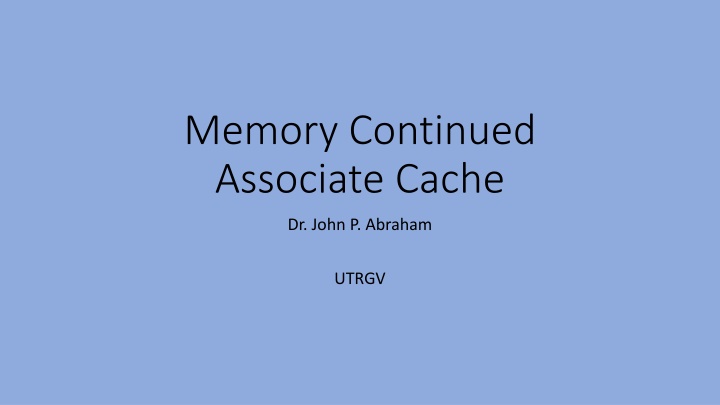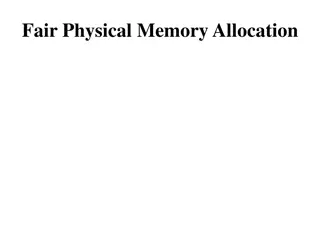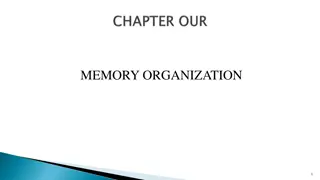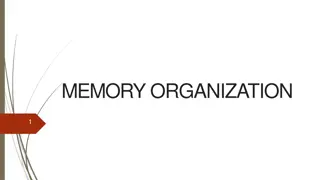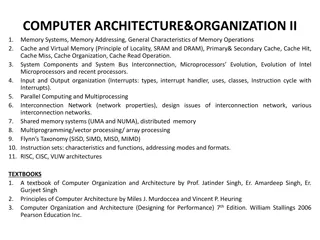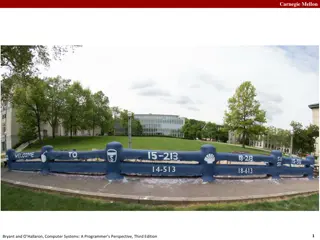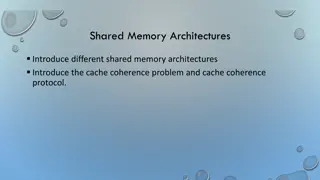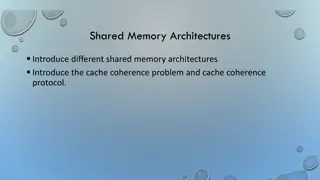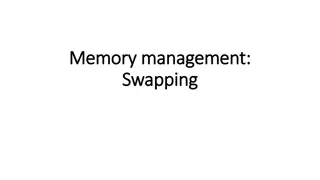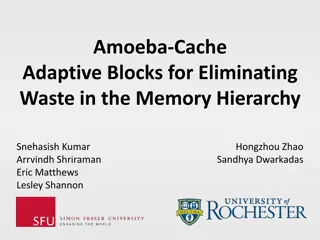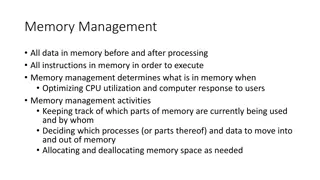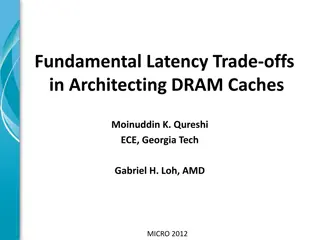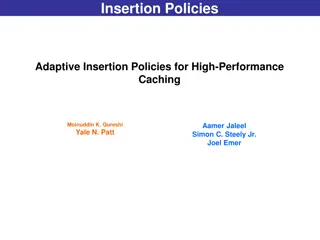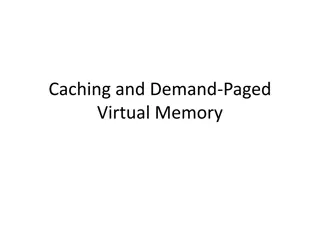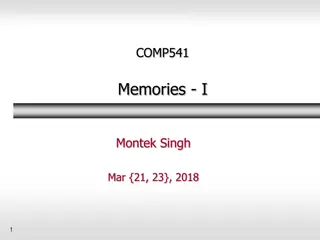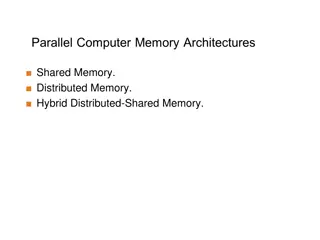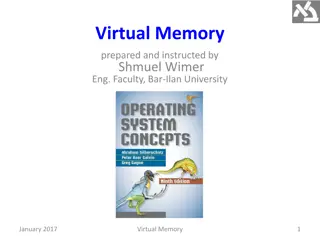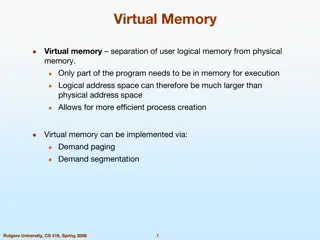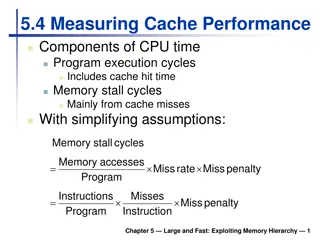Cache Memory in Computer Systems
Explore the intricate world of cache memory in computer systems through detailed explanations of how it functions, its types, and its role in enhancing system performance. Delve into the nuances of associative memory, valid and dirty bits, as well as fully associative examples to grasp the complexities of cache management. Gain insights into the workings of Intel processors with multicore capabilities and the interplay between CPU, RAM, and cache. Unravel the essential concepts behind cache addressing, block sizes, and tag management for a comprehensive understanding of memory optimization in computing environments.
Uploaded on Sep 26, 2024 | 2 Views
Download Presentation

Please find below an Image/Link to download the presentation.
The content on the website is provided AS IS for your information and personal use only. It may not be sold, licensed, or shared on other websites without obtaining consent from the author.If you encounter any issues during the download, it is possible that the publisher has removed the file from their server.
You are allowed to download the files provided on this website for personal or commercial use, subject to the condition that they are used lawfully. All files are the property of their respective owners.
The content on the website is provided AS IS for your information and personal use only. It may not be sold, licensed, or shared on other websites without obtaining consent from the author.
E N D
Presentation Transcript
Memory Continued Associate Cache Dr. John P. Abraham UTRGV
CPU is unaware of cache CPU issues a memory address and expects a result back. Each RAM address does not need a label, simply wired to each block. The request is intercepted by the cache hardware that sits between the CPU and the memory. 64 byes blocks usually. Cache is not unique to memory; there is a cache between hard drive and RAM (4 KB page size)
Intel processor I7 with multicore Has Level 1 instruction cache and level 1 data cache for each core (32K), takes about 4 cycles. instructions don t need to be written back to RAM data may need to be written back, so use a dirty bit (next slide) Has level 2 cache for each core (256K), takes about 11 cycles. Also has a common level 3 cache for the entire CPU (8 M), takes about 40 cycles. RAM is generally 16 G, takes about 50 to 200 cycles.
Associative Memory (cache) Each block is identified by a key or tag (recall from slide 1, RAM does not have need a tag). This tag goes along with the contents of the memory. https://miniwebtool.com/log-base-2-calculator/ good for cache calculations. Given RAM size of 128 K, cache memory size 16 K, block size 256 bytes and byte addressable. To address 128 K memory it requires 17 bits. So tag and offset should be 17 bits Offset for 256 bytes is 8 bits The remaining bits (17-8=9) will be used for the Tag in a fully associative. So in addition to the contents of the memory, each line of cache should contain tag information, a dirty bit, and a valid bit
Valid bit and dirty bit When computer boots cache is not populated with valid data. So the bit should be set to 0. When a block is brought in the valid bit should be set to 1. This should happen also when processes are swapped in. When a data is updated, the new value can be written directly to cache and memory immediately (write-through), or it can just update the cache anticipating further changes; and set the dirty bit to 1. Before evicting the line to bring another line, if it has a dirty bit, it should be written to the RAM (this is called Write-Back)
Another fully associative example Given RAM of 4GB, cache 4MB, and block size 1KB. Bits required to address RAM is 32 Total number bits required to address cache is 22 Number of cache lines is 22-10 = 12 so we need this many comparisons. Required bits for block offset is 10 Tag for fully associative is 32-10 = 22 The tag will indicate where in RAM this address can be found. Tag__22___Offset 10 Cache hardware need to do parallel comparisons of 2^12 and do OR operations on all of them to determine if there is a Hit or Miss.
Same memory but different block size RAM 4 GB. Block Size 64 bytes. Requires 32 bits 64 bytes require 6 bits 26 6 Tag Offset
4-way associative cache using the same numbers Given RAM of 4GB, cache 4MB, and block size 1KB. Bits required to address RAM is 32 Total number bits required to address cache is 22 Number of cache lines is 22-10 = 12, but these are divided into 4 lines per set, giving us 2^10 sets Required bits for block offset is 10 12 10 10 Tag SetNo Offset
Reads from the RAM - Cache hit and miss CPU issues an address, cache hardware intercepts it and extracts tag field. Compares the cache tags (if direct mapping it is easy, only need to check one line). If found and if the valid bit is on, we have a hit. Return the value to the CPU Otherwise it is a miss. Cache must get the block from the RAM. Before retrieving the data one line must be evicted. If it is direct mapped, we know which one. But before evicting, check dirty bit, if it is on, write the content back to the RAM and then replace If not direct mapped, use an algorithm such as LRU, random, FIFO or LIFO to determine which line to be evicted then check dirty bit, and such.
Writes to the RAM CPU issues the memory address and data to be written Compare address with cache tag, same as previous slide If cache has the block, then use one of the following: Write-through. Update the cache and the RAM immediately Write-back. Update the cache only and turn on the dirty bit. Only writes to the RAM when that line is evicted. If cache does not have the block use one of the following: Write-allocate: Read the block from RAM into the cache and update the cache with CPU instruction and set dirty bit to 1. Only written to RAM when the block is evicted. No-Write-allocate (or write around): Send the write on through to memory, do not load into cache. Write-through may be better with write-hits and no-write allocate with write misses.
Your Textbook Appendix B What I covered is mostly from Appendix B. Cache performance: Avg mem access time = Hit time + miss rate x miss penalty The access time can be further dived into instruction hit and data hit. In out of order executions, instruction may not be in the cache
Six basic cache optimizations 1. Larger block sizes reduce miss rate 2. Larger cache
continued 3. Higher associativity
Continued 4. Multilevel caches 5. Give priority to reads before writes 6. Avoid address translation during indexing of cache This is due to virtual machines and virtual caches. Not explained here in this class.
Chapter 2: Memory Hierarchy Design We already discussed this. Text gave 10 optimizations to improve cache performance, many of these won t make sense to you until I cover pipelining and ILP. Book also discussed memory protection and virtual machines when using cache. Coherency of cache when multiple cores or CPUs are used also discussed as data will be distributed to several caches.
